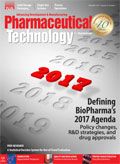Global Drug Spending: A Look Ahead
Estimates that global medicine spending will reach nearly $1.5 trillion by 2021 and the types of therapies and use of innovator versus generic drugs, will vary by region.
The QuintilesIMS Institute, in its annual projections for global drug sales (1), estimates that global medicine spending will reach nearly $1.5 trillion on an invoice price basis by 2021; the total volume of medicines consumed globally will increase 3%. The types of therapies and use of innovator versus generic drugs, however, will vary depending on where patients live.
Consumption of newer drugs in developed markets, more generic drug use in pharmerging markets, plus patent expiries, discounts, and rebates will result in a 4-7% compound annual growth rate (CAGR) to 2021, slower than the nearly 9% CAGR in 2014 and 2015 when expensive new hepatitis drugs distorted the annual growth rates, but similar to the 5.9% growth during the past five years. Future growth will be generated by autoimmune, oncology, and diabetes treatments.
The report predicts that specialty drugs to treat chronic, rare, or genetic diseases will be more widely used, particularly the US and European markets, thanks to the approval of breakthrough medicines and a greater focus by payers on drug value and performance. Spending on such therapies, which was 20% of all medicines spending 10 years ago, will rise to 30% in 2016 and to 35% by 2021 and will represent half of the medicine purchases in the United States, Germany, United Kingdom, Italy, France, and Spain.
The US remains the top spender on drugs ($461.7 billion), followed by China ($116.7 billion), Japan ($90.1 billion), Germany ($43.1 billion), France ($32.1 billion), Italy ($28.8 billion), UK ($27.0 billion), Brazil ($26.9 billion), Spain ($20.7 billion), and Canada ($19.3 billion).
In the pipeline
More than one-quarter of therapies in the late-stage pipeline are focused on oncologic drugs, thanks to recent successes in cancer therapeutics and opportunities created by breakthrough therapy designations. Therapies for central nervous system disorders make up 12% of the pipeline, followed by anti-infectives and antivirals (8%), cardiovascular (6%), arthritis/pain (6%), immune system (5%), and genito-urinary and hormones (5%), according to IMS data.
An improved understanding of the underlying mechanisms of diseases, and maturity in the development of immunotherapies and targeted therapies, will drive innovation, the authors report. Regenerative cell therapies, blood components, the human microbiome, and gene editing will be emerging research areas.
A mix of large, mid-size, and small companies have molecules in the oncology drug development arena. QuintilesIMS reports that while large companies are familiar with regulatory and logistical challenges, smaller companies have specific expertise with a specific mechanism of action or drug development platform that provides a research edge. Strategies moving forward include sale of assets, partnerships, or working independently. Outsourcing may also play a role.
US drug costs
The QuintilesIMS report estimates that the 12% US market growth in 2015 will be only 6-7% for 2016, and is forecast to average 6-9% through 2021. Factors for the decline include more patent expiries, historically high price increases for innovator and generic drugs before off-invoice discounts and rebates in 2014 and 2015, and the newly introduced hepatitis C drugs. When accounting for price concessions, spending growth is estimated to grow at 4-7% CAGR.
Reference
1. M. Aitken, M. Kleinrock, and D. Nass, Outlook for Global Medicines through 2021, Balancing Cost and Value, QuintilesIMS Institute, Parsippany, NJ, December 2016).
Article Details
Pharmaceutical Technology
Vol. 41, No. 1
Page: 18
Citation
When referring to this article, please cite it as R. Peters, “Global Drug Spending: A Look Ahead," Pharmaceutical Technology 41 (1) 2017.
